Archive of ‘Uncategorized’ category
Alcohol advertising in the UK is subject to some of the most rigorous rules in the world. For reasons which are very straightforward that is, as noted by Snyder et al (2006), youth who saw more alcohol advertisements on average drank more.
They place a particular emphasis on protecting young people. Alcohol ads must not be directed at people under 18 or contain anything that is likely to appeal to them by reflecting youth culture or by linking alcohol with irresponsible behaviour, social success or sexual attractiveness.
These mandatory rules, as independently regulated by the Advertising Standards Authority (ASA) apply across all media, whether offline or online.
Which brings us to social media. How does an alcoholic beverage brand successfully run a social media channel, full of appealing content and personal engagement while sticking to the right side of the regulations?
Korgaonkar et al (1986) suggested 3 ways in which an ad campaign can be classed as successful:
- Ensure the correct intention of the campaign is set out clearly.
- Make sure your ad campaign is unique to another other competitor.
- Ensure your company has enough resources to adapt to the situation (rewards, difficulties).
Lets take a look at some of the most popular brands in the UK…..
Carling
Carling’s most successful strategy surrounds its #CarlingOfficeEscape campaign. This contest earned the company its most shared response on social media with the amount of likes and retweets it received.
An example..
https://www.youtube.com/watch?v=YZFA1K3SA2A&spfreload=10
With many adverts floating around the TV, the response to this was unfathomable and here are just a few responses from twitter.
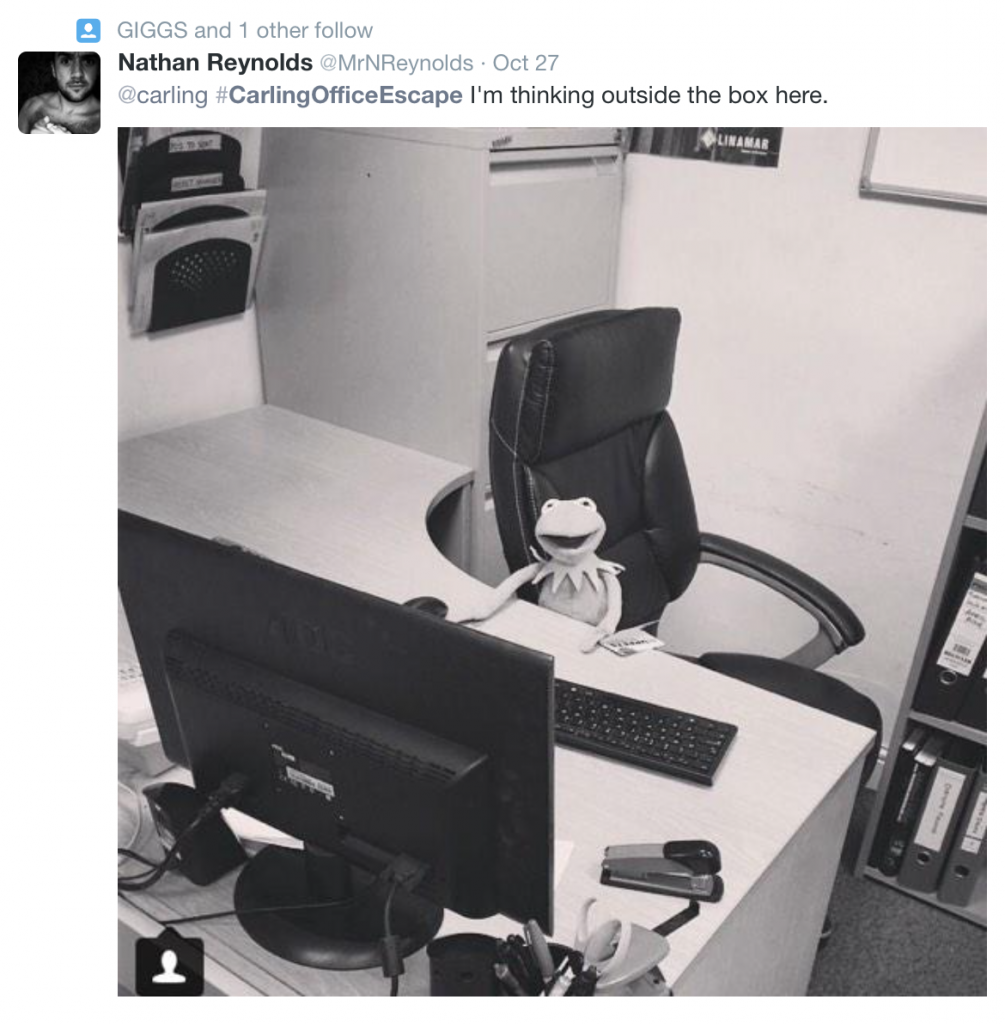

Again, aligning itself with sporting events gives Carling something to talk about and inspires shareable content. Making the company heard around the time when the Ryder Cup was on was a great move for the company.
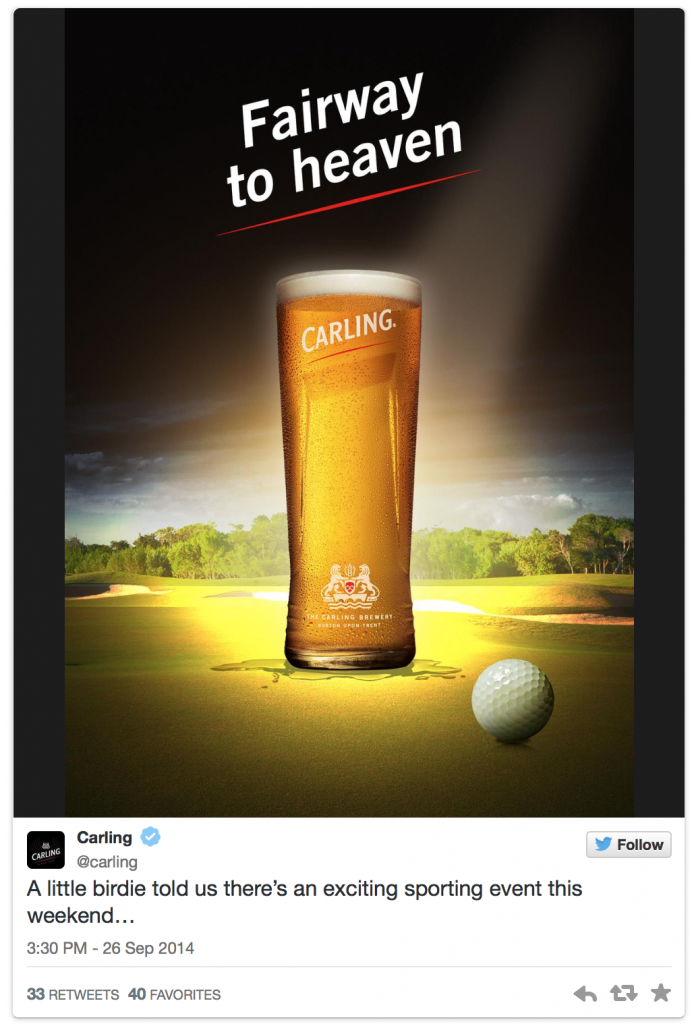
Fosters
Foster’s now exclusively tweets from its Foster’s Funny Twitter account. Here you’ll find the two Australians from its TV commercials repurposed into various memes and awkwardly Photoshopped images.
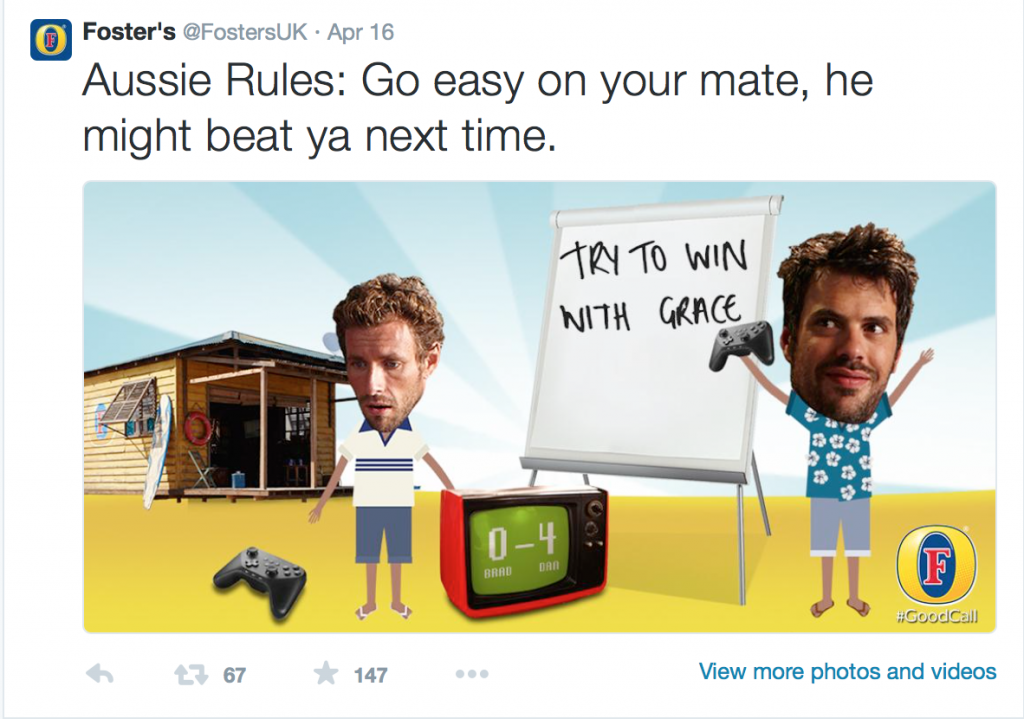
Using these two established characters that already fit the tone of your products provides Foster’s with endless content and can continue to run the joke that many of us find amusing. #GoodCall
However, there is a negative side, if you’re just relying on the same characters then you’re running the risk of putting followers off who are getting sick of them. If you scroll back through the site, you’ll see that this has been going on for over a year! Cor’ blimey.
Guinness
Guinness has many years worth of marketing wins in the bank, thanks to its groundbreaking and classic television adverts.
Its Twitter feed doesn’t exactly set the world alight in the same innovative way, instead it offers old-world warmth, comfort food and nostalgia.
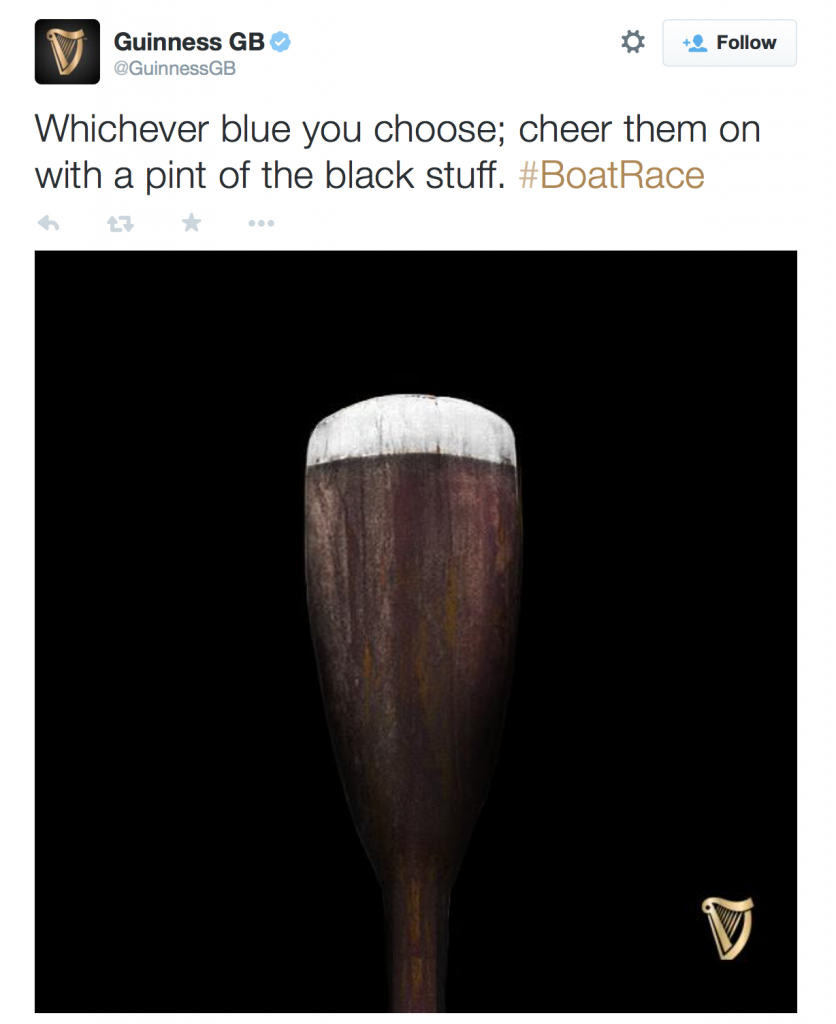
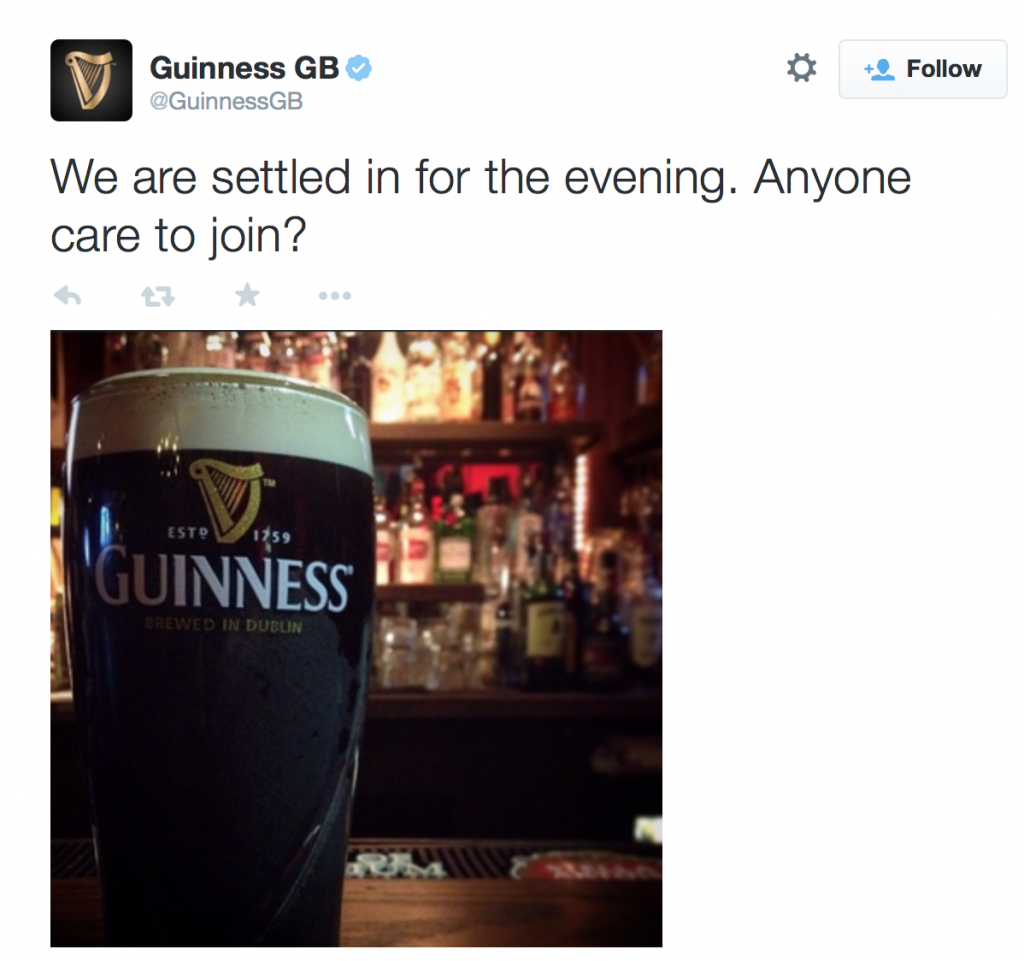
Guinness is also one of the few beer brands here that makes a point of regularly making the ‘enjoy responsibly’ message clear and includes a link to drinkaware.ie.
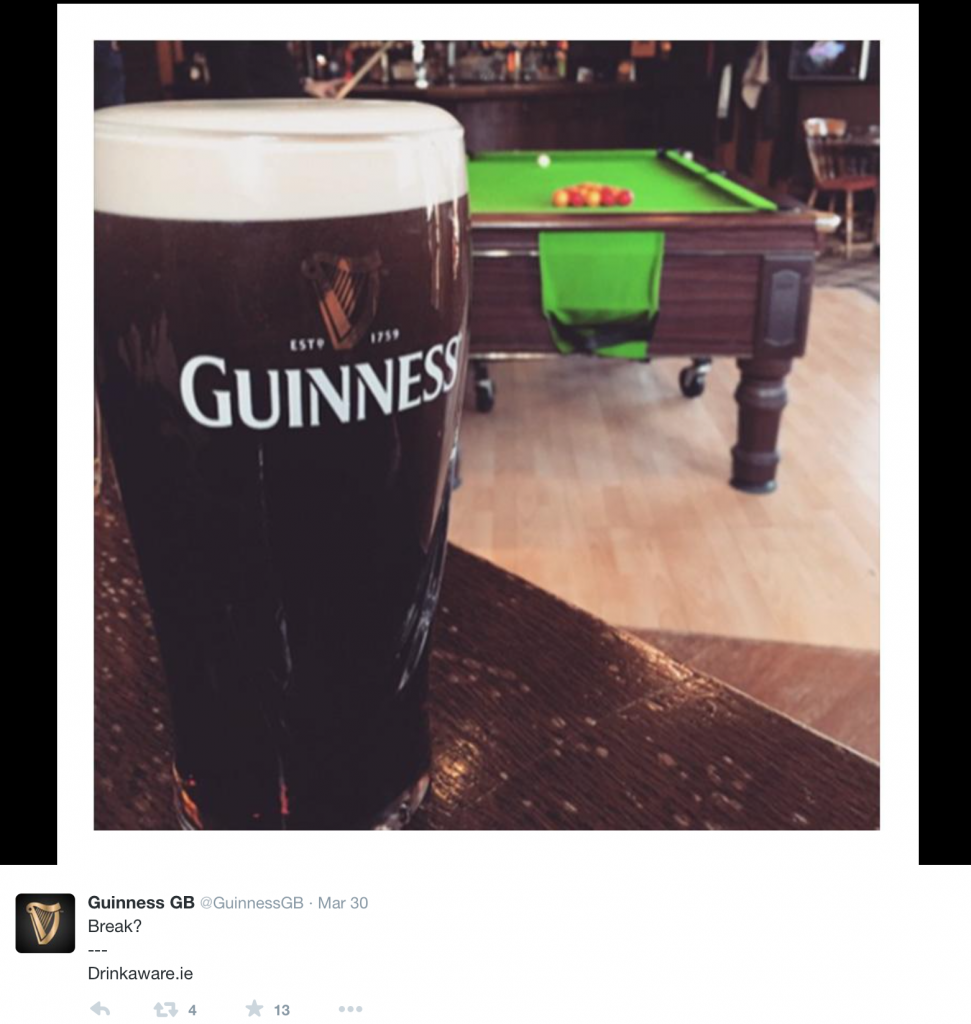
Are Beer brands acting responsibly?
You can make your own assumption from the examples above that only guinness are the ones that are promoting a drink aware campaign and are the only ones acting mildly responsible. However it is not up to them to completely eradicate this from their social media sites. They state on their biographies that their sites are over 18’s and that they hold no responsibility, therefore is it really their problem if an under 18 drinks more if they look at the company’s twitter?
Korgaonkar, P.K., Bellenger, D.N. & Smith, A.E. 1986, “Successful industrial advertising campaigns”, Industrial Marketing Management, 15(2), pp. 123-128.
Snyder L,B., Milici F, Slater, M., Sun, H., Strizhakova, Y,. 2006. Effects of Alcohol Advertising Exposure on Drinking Among Youth. Arch Pediatr Adolesc Med. 160(1): pp. 18-24
So as we all know, social media is becoming a much stronger player in digital marketing terms, with 46% of web users look towards social media when making a purchase.
Question is, what do different companies do, and is it effective?
As Saravanakumar & SuganthaLakshmi (2012) noted, Social media has become the method of statement in the 21’t century, enabling us to express our belief, ideas and manner in a absolute new way. Also, Mangauld & Faulds (2009) argue that social media is a hybrid element of the promotion mix because in a traditional sense it enables companies to talk to their customers, while in a non-traditional sense it enables customers to talk directly to one another.
Pepsi
Facebook
Pepsi’s Facebook page is a bit of a strange one. It has over 32 million fans yet they haven’t completely grasped the idea of social media. With updates once a month or less.
In fact one of the most recent updates is a pop quiz regarding the World Cup…. Which was in 2014.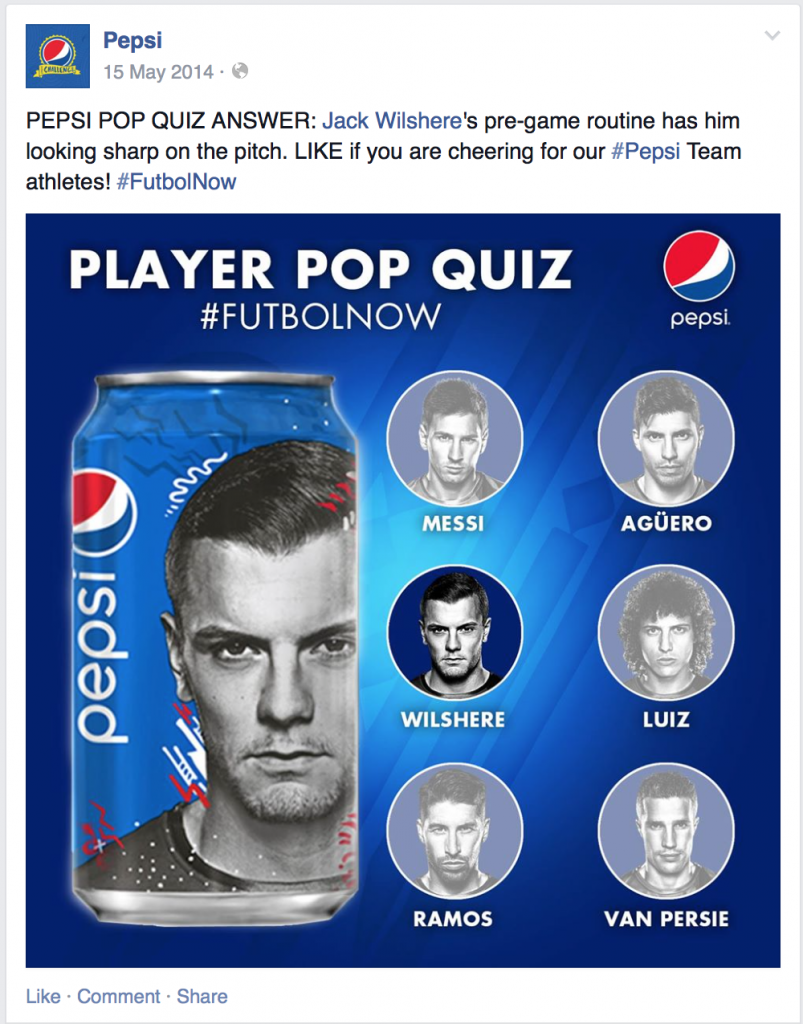
The updates achieved almost zero interaction though, with very few achieving more than 50 comments and ‘likes’, which is also odd as although they’re extremely brand focused they aren’t much worse than a great deal of other corporate Facebook updates.
Twitter
Pepsi is another brand with a confusingly broad range of Twitter feeds. There’s PepsiCo, Pepsi Max, Pepsi Max Crew, PepsiCo Deals and many many more… as well as feeds for many of the countries in which the drink is sold.
In terms of their activity on this, you couldn’t really think it would be much worse then their Facebook page, and your right! A tweet every other day seems to be the plan for Pepsi regarding their Twitter activity. Although most posts are of sponsorship with celebrities such as Meghan Trainer (Who sung all about that bass?), Fall Out Boy and many other sport celebrities.
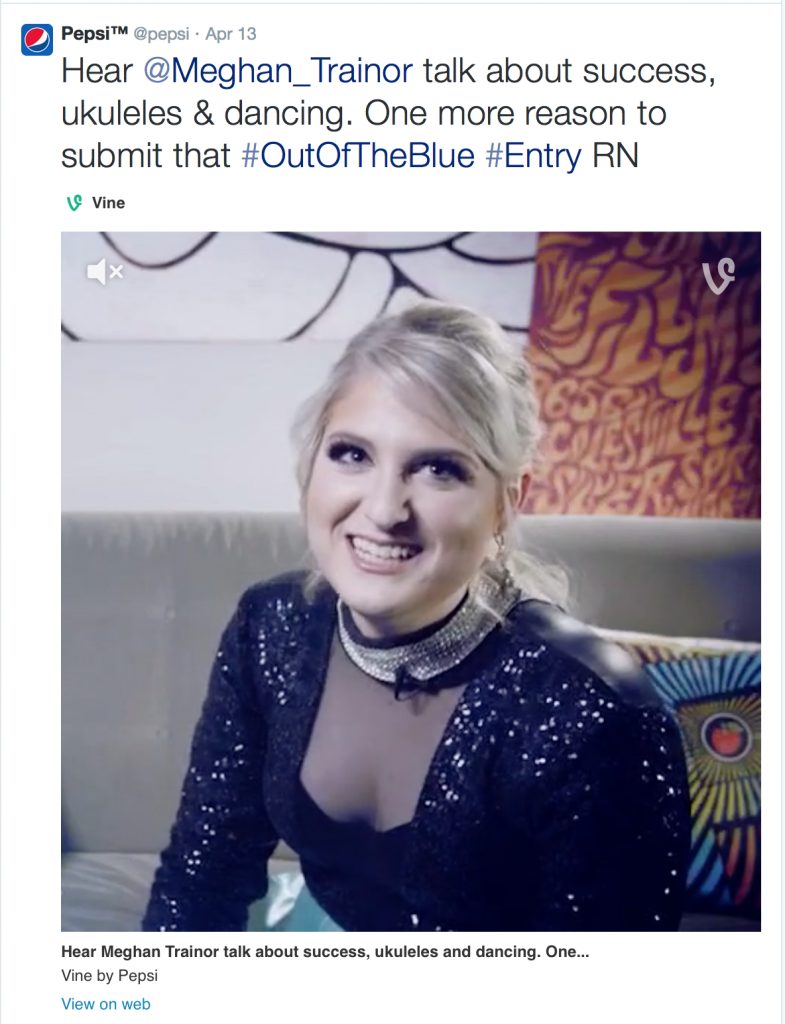
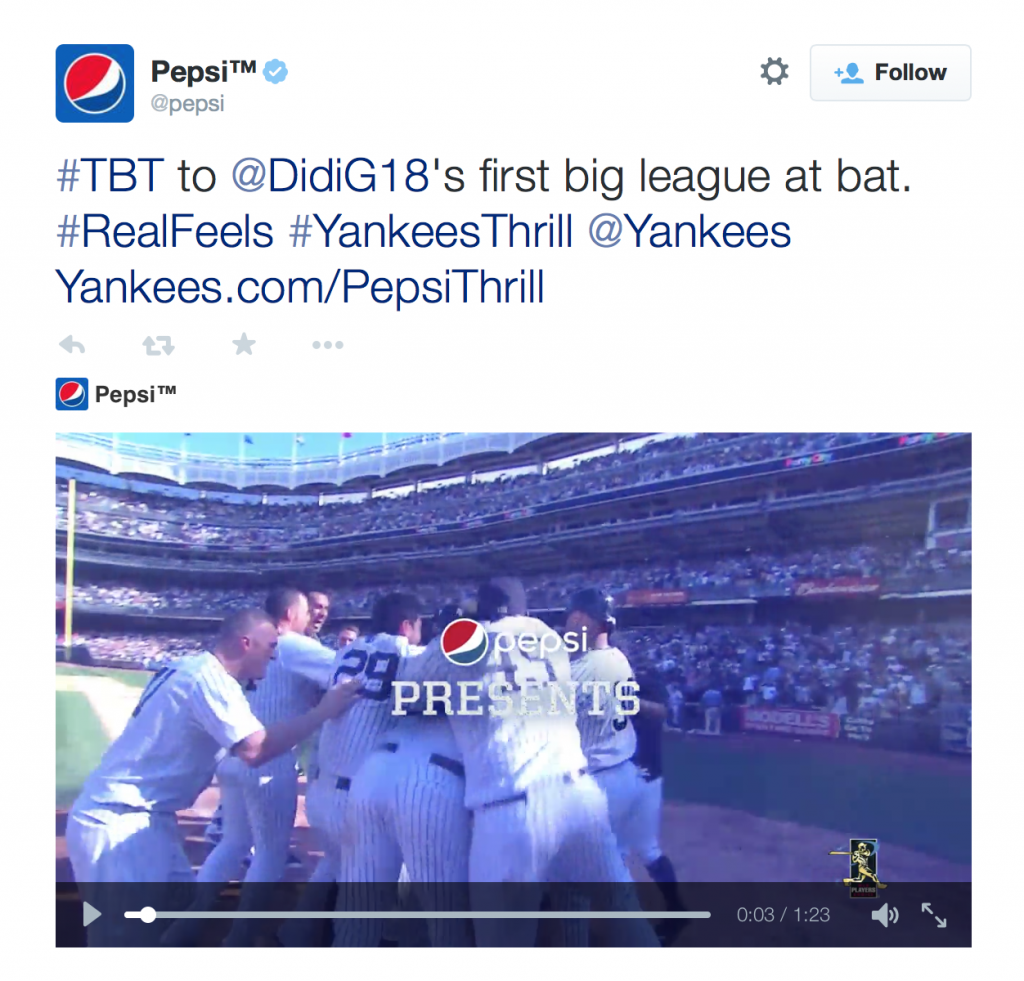
The idea is to promote Pepsi as an exciting, youthful brand that people associate with having a good time, so its feed is littered with hashtags such as #LiveForNow, #IconicSummer, #Vibes and #duh.
Google+
Pepsi is another brand that puts very little effort into it’s Google+ page and generally posts just one or two updates per month. Even so, it has managed to attract just over 700,000 followers.
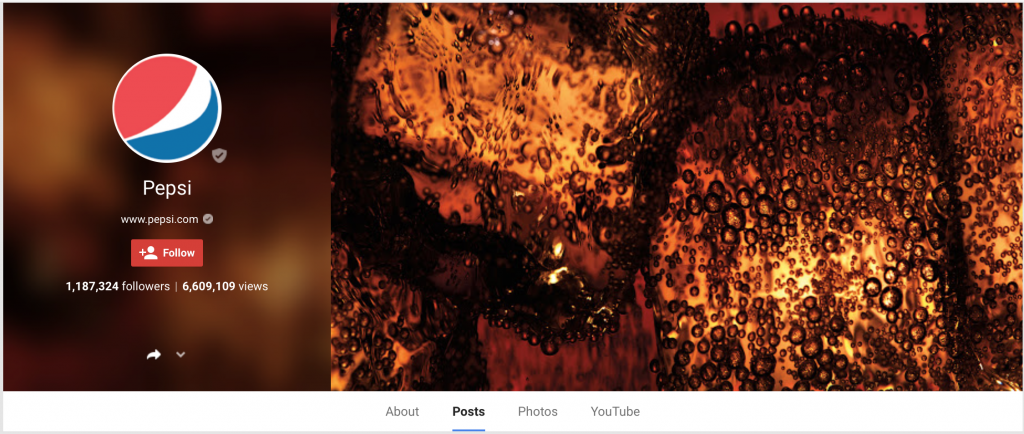
The posts tend to be images or videos of Beyoncé or other musicians, and rarely achieve more than a few hundred interactions.
Manchester United
Facebook
With over 64 million Facebook likes, MUFC dwarfs pretty much all brands on Facebook. They have now surpassed Lady Gaga (61m) and It’s only celebrities such as Rhianna (81m) that beat these kind of figures.
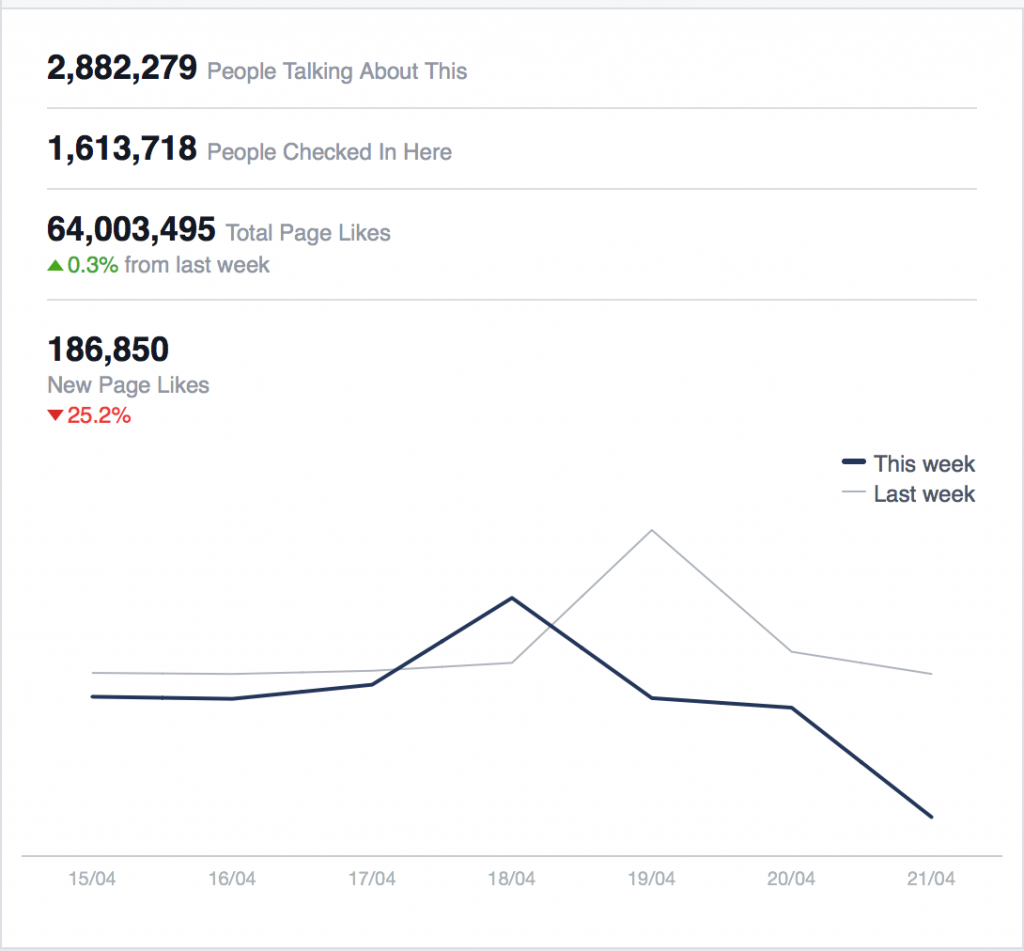
Barcelona is the top sports team in terms of likes, with around 81m. Again, MUFC posts here around 2-3 times a day, and doesn’t really engage with its fans, likely because there’s a problem with scale. MUFC also heavily incorporate many competitions for their fans to engage with and win tickets.
Twitter
At the moment, the account is an active broadcaster, with around 10 tweets per day (gaining 1k to 3k retweets each). However, the account isn’t replying to any of its followers. However, they do retweet many fan’s replies. However, they tend to just post pictures and commemorate old players/managers.
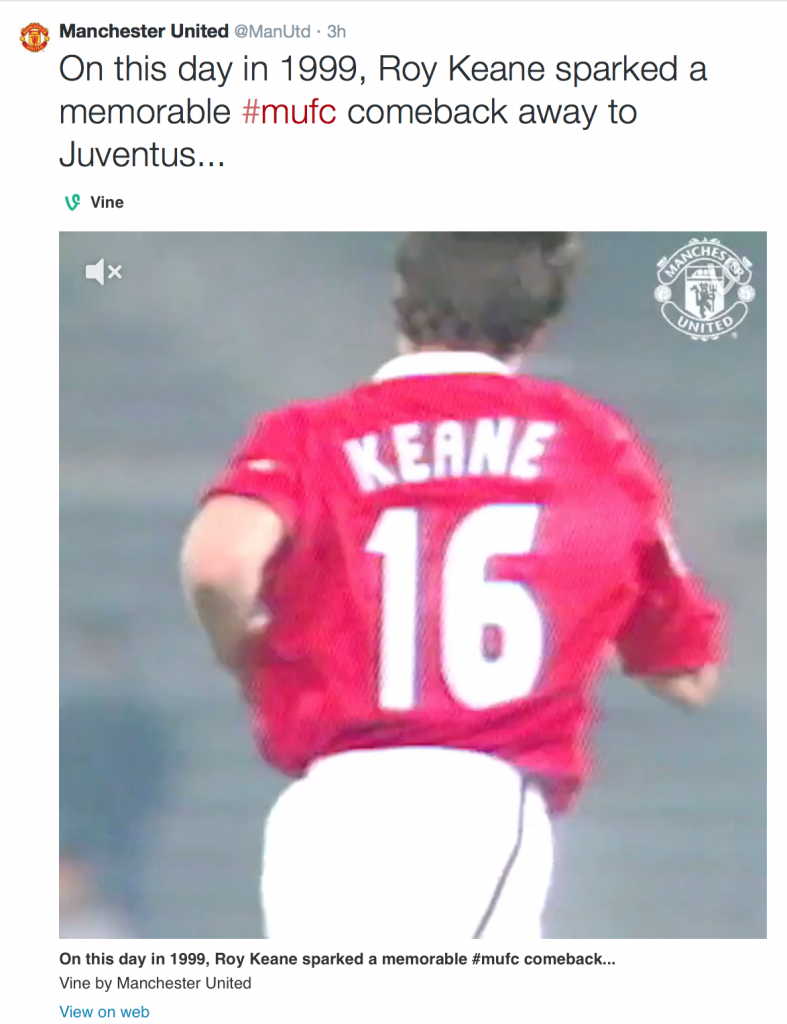
Tiffany
Facebook
Tiffany has more than Seven million fans and generally posts more or less once per day. A vast majority of posts are simple product images or albums complete with links to its ecommerce page. However, the difference for this company is the interaction with its customers. Each post generally gets between 2,000 and 6,000 likes. This high number of interactions is probably due to the fact that Tiffany & Co. is an iconic, aspirational brand that people want to be associated with, therefore they’re happy to give a $10,000 necklace a digital thumbs-up.
With this $12,500 ring getting over 5,000 likes.
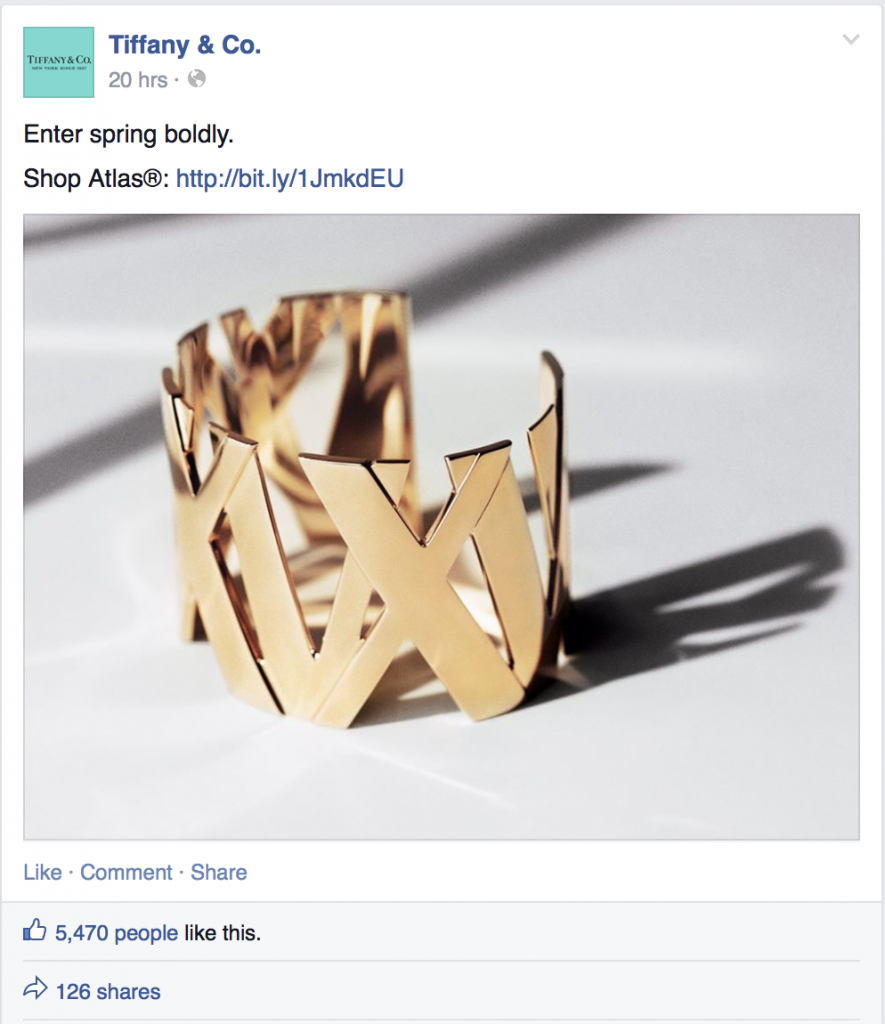
Twitter
The twitter account for Tiffany tends to tweet between 5 and 10 times per day, and is generally a mix of product suggestions, images, promos for its engagement ring finder app and links to other social accounts.
Overall the emphasis is more on broadcasting marketing messages rather than actually engaging with other users, however the content that Tiffany & Co. posts is probably quite interesting for a certain demographic and as such it has almost 600,000 followers.
So overall, we can see that different companies resort to different strategies when using social media. Social media isn’t going anywhere and businesses now realize that if they wish to reach their prospects and customers, their online presence in social media is a foundation of their overall marketing strategy.
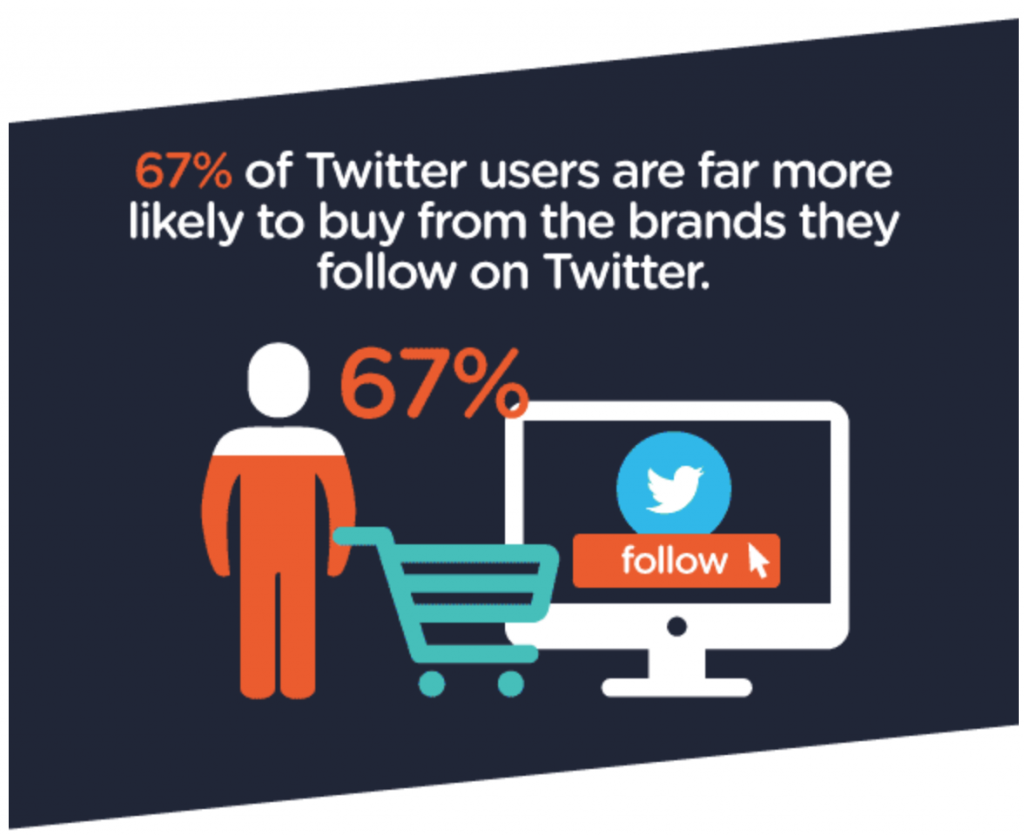
(Source: MarketingTechBlog)
Recommendations
So what can companies do to ensure their social media marketing it up to scratch?
- According to Tiago and Verissimo (2014) consumers have been shown to value peer judgements more than firm promotions which indicates a shift in the locus of persuassive power which can also affect reputaion. Therefore it could be beneficial to incorporate other customers views and opinions through social media to market their products.
- As Chaffey (2009) pointed out social networks influence consumer’s perceptions about brands, products and suppliers. If companies can ensure their presence on social media is positive they can expect to a rise in consumer recognition.
- People feel that these companies are invading their personal space, be it their Twitter Feed or their Facebook timeline. (Richmond, S. 2014). Therefore being too ‘pushy’ to your followers and fans can cause them to stay away from the company and their product because they don’t enjoy their marketing.
Chaffey, D. (2009) E-Business and E-Commerce Management. 4th ed Harlow: Pearson Education Limited
Evans, D. & Dawsonera 2011, Social media marketing: the next generation of business engagement, Wiley Technology Pub. pp 3-4
Mangold, W. G., & Faulds, D. J. (2009). Social media: The new hybrid element of the promotion mix. Business horizons, 52(4), pp. 357-365.
Richmond, S. (2014) Email Marketing or Social Media; which has the biggest impact on the UK Retail Industry?
Saravanakumar, M., & SuganthaLakshmi, T. (2012). Social media marketing. Life Science Journal, 9(4), pp. 4444-4451.
Tiago, M., & Verissimo, J. (2014). Digital Marketing & Social Media: Why Bother? Business Horizons, 57(6), pp703-708
User Generated Content (UGC) is the process of “people who voluntarily contribute data, information or media that then appears before others in a useful or entertaining way” (Krumm, J. 2008). This can be through comment sections, ratings & reviews or personal videos/vlogs.
The question we’re asking here is whether starting a UGC is worth the hassle that they come with? To answer this, we will be looking at a few examples of what companies have done in the past to boost their brand.
Campaigns that Worked
1. Coca-Cola
Coca-Cola had most notoriously and most recently one of the best user generated campaigns ever. They came up with the ‘Share a Coke’ campaign where the company produced Coke bottles with peoples names on them. They then handed these out in hundreds of cities around the world to gain more publicity and exposure on social media, most notably on Twitter. This increased their electronic word of mouth which is the ‘Informal, non-commercial, oral and person-to-person communication about a brand, a product or a service between two or more consumers’ (Arndt, 1967). After a decade of declining revenue, Coca-Cola announced a 2% increase in U.S Sales after this campaign. As noted by Engel et al (1993) the level of interest of involvement in the topic under consideration serves to simulate discussions.

2. Burberry
Burberry recruited a new CEO in 2006 called Angela Ahrendts. She decided to launch a user generated content strategy as she believed burberry were being recognised as an ageing brand, therefore she was trying to spruce things up with the company. Burberry launched The Art of the Trench website in 2009, where users could upload and comment on pictures of people wearing Burberry products. This is a form of product recommendation, as suggested by Balasubramaniam, N. (2009), this has been proven successful in driving sales, most notably in the grame of e-commerce platforms. This is represented for Burberry, as ecommerce sales surged 50% year-over-year following the launch of the site.

3. Belkin & Lego
In 2013, Lego and Belkin came together and proceeded to develop a line of customisable iPhone cases. The company then created a social platform for customers, giving them a place to share pictures of their cool new cases and to show others the benefits of making their own. This attracted new customers to the website because they believed this was a interesting idea.
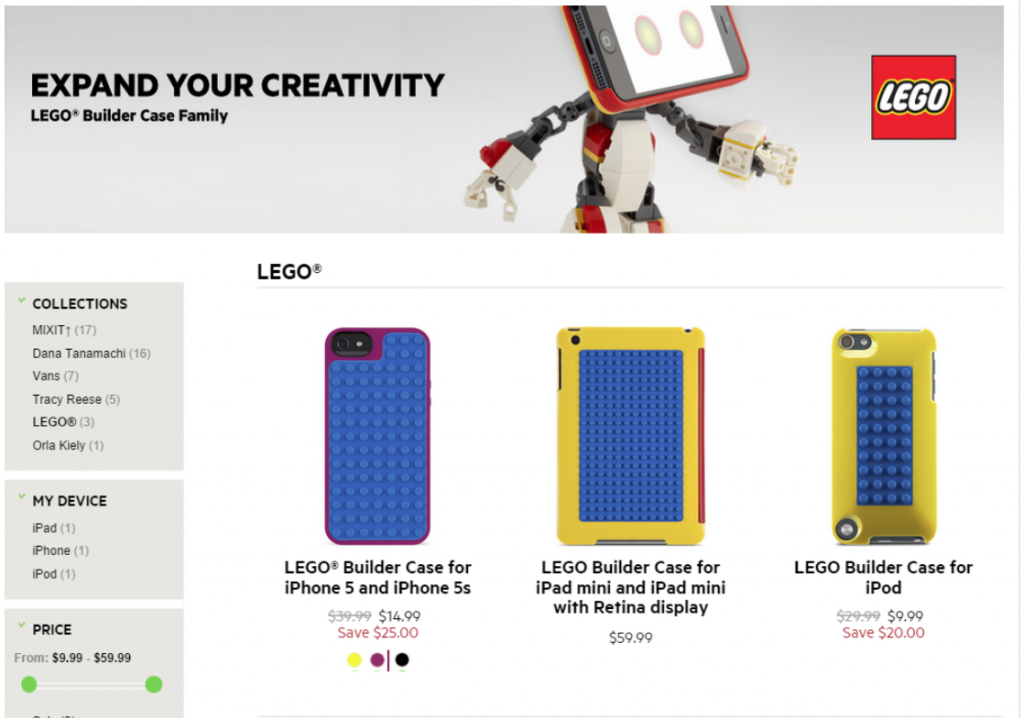
Sometimes UGC campaigns don’t work out too well either. The problems surrounding UGC however, is the loss of control is has for the companies. The users are not your employees so they may end up saying or moving conversations in directions you are not anticipating. This is particularly true if you launch a product that does not meet expectations.
Starbucks
UCG is very hard to have any filtering on, therefore you are always at risk of bad language to be used when its out of your control. This is what happened with Starbucks back in 2013 christmas time. Starbucks started a hastag which was #SpreadTheCheer. They were also sponsoring an event at the Natural History Museum in London. The deal included allowing Starbucks to broadcast #SpreadTheCheer tweets live on the wall of the ice rink at the Museum. An example below…

This lead to a variety of foul-mouthed tweets being displayed on the outside of the Natural History Museum which lead to a number of complaints towards the company (HuffingtonPost, 2012).
What are the implications surrounding UCG?
Tourism
Recent research carried out by De Asciniis & Morasso (2011) suggests that UCG become very important for the reputation of destination because of the fact that customers are giving their honest opinions about certain places, rather than the company/marketer advertising it.They can be used to verify the actual reputation of a destination and, from the other side, they contribute fixing such a reputation (Albâstroiu & Felea, 2014).
New Identity for Brands
UGC is also considered to give different opinions about a certain brand through consumers and their experience with them. Muniz and Schau’s (2007) work highlights that brand communities engage with UGC to fill a void left by conventional media, often giving brands a new identity.
So how should you run your own UGC?
Launching a user generated content campaign can be one of the most effective ways to build your brand, as demonstrated by the companies listed above. Here are a few tips to ensure a good quality UGC campaign.
- Match your Promotion type to your Audience
- Ensure no Legal Issues surround the UGC
- Request entries that you can use in your marketing campaigns.
- Most brands offer prizes to consumers who participate in UGC
Albăstroiu, I., & Felea, M. (2014). The Implications of User-Generated Content Websites for Tourism Marketing. International Journal of Economic Practices and Theories, 4(2), pp.222-229.
Arndt, J. (1967). Role of product-related conversations in the diffusion of a new product. Journal of marketing Research, pp.291-295.
Balasubramaniam, N. (2009). User-generated content. In Proceedings of business aspects of the internet of things, seminar of advanced topics pp. 28-33.
De Ascaniis, S. And Greco Morasso, S., (2011), When tourists give their reasons on the web: The argumentative significance of tourism related UGC. Information and Communication Technologies in Tourism. pp.125-137.
Engel, J. F., Blackwell, R. W., & Miniard, P. W. (1993). Understanding the consumer. ESCO Public Relations for FD’s, pp.1-9.
Huffington Post. 2012.Available at: http://www.huffingtonpost.com/2012/12/17/starbucks-spread-the-cheer_n_2317544.html
Krumm, J., Davies, N., & Narayanaswami, C. (2008). User-generated content. IEEE Pervasive Computing, 7(4), pp.10-11.
Muniz, Albert M,. Schau, Hope J. Vigilante marketing and consumer-created communications. Journal of Advertising Research 2007; 36(3): 35-50.
Twitter has recently announced the new idea surrounding ‘Twitter Payments’ which would allow users to send over money from their bank accounts to another with just one tweet! Crazy huh?.
Smith (2006) defines m-commerce as the buying and selling of goods and services through wireless handheld devices such as cellular phones and Personal Digital Assistants (PDA)
An example of this:
 (Source: Getty)
(Source: Getty)
Technology Giants Already Embracing Mobile Commerce:
Facebook is already working on its own payments system which will reportedly be operated through the messenger application (2014). Other leading online companies such as Amazon and Paypal already have payment systems in place. Most recently, Apple launched its new service Apple Pay, which allows users to pay for goods and services both online and in the physical world using just their phone. An example of Apple pay can be found through this link: http://www.cnet.com/videos/link/LhuNa4mKgHThEQ0h6j3vt0AwQCKeQtNi/

Why Should your Company Consider Using Mobile Commerce too?
According to the Centre of Economics and Business Research, 5.6 million people in the UK use phones to purchase goods and services. While the value of goods and services bought on a mobile device are expected to nearly triple in 2018. This suggests that moving onto mobile commerce and integrating payments within your websites could create large profits in the future.
Paypal have stated that, “The rapid adoption of Smartphones is driving a surge in the number of consumers using their mobile devices to access the internet and complete eCommerce transactions”. With their company now boasting and annual revenue of 8.03 billion dollars and over 3.9 billion payments, which is a growth of 22% from 2013.
The Barriers of Mobile Commerce
1. Trust
Trust is perhaps the most important influence on information disclosure (Hoffman et al, 1999). The Internet Consumer Trust Model developed by Jarvenpaa and Tractinsky (1999) and the Electronic Exchange Model by Swaminathan et al. (1999) find trust to be a key priority to engaging in consumer transactions online because it reduces the risks associated with purchasing goods and services over the Internet.
2. Concern for Privacy
Culnan & Armstrong (1999) suggest that privacy for users is a large problem when it comes to commercial websites. Individuals’ concern for privacy increases when they feel the need to register and and out personal information. A survey completed by Sheehan & Hoy (1999) found that customers are providing incomplete information when they do register, presumably because they have less trust in the Web site.
What can you do to get Started?
1. Make Sure its Optimised for Every Device
According to Google, 67% of people are more like to buy from a mobile friendly site. Whereas, 61% are eager to leave when they can’t find what they are looking for (Google, 2012). This makes it vitally important to ensure that your website is responsive and/or mobile optimised. Customers will more be more likely to browse round your website more if the site is easy-to-use. This would typically be used with Cascading Style Sheets (CSS3) which is a programme which allwows the designer and the user to control the presentation of a web page. According to Reed et al (1998), cascading style sheets will prove to be one of the most powerful tools available for the web designer as you are able to control just about every part of your web page.
2. Make sure it’s Secure..
According to the Mobile Payment and Fraud Survey (2014), 32% of merchants see mobile payments as riskier then standard eCommerce sites. Having a secure payment process and clearly stating your security settings to your customers is essential for potential buyers as they would feel safer knowing their money is safe and they are getting their money’s worth. Early research of this suggested that once a secure platform is created and there are no loopholes, we can expect to see very high value transactions occurring on mobile platforms (Barnes, S. 2002).
3. Simplify Your User Experience
Theres never been a more important decision then to make your business website or platform as easy to use as you can. Potential customers will get annoyed, scared and bored of a website they can’t understand how to use. Minimising the steps they need to take to purchase a product, clearly label every little detail on your website and your customer will feel suitable for that website. According a survey done by Backspace survey (2013), 71% of people agreed that a simpler web design influenced their decision to buy on a mobile device.
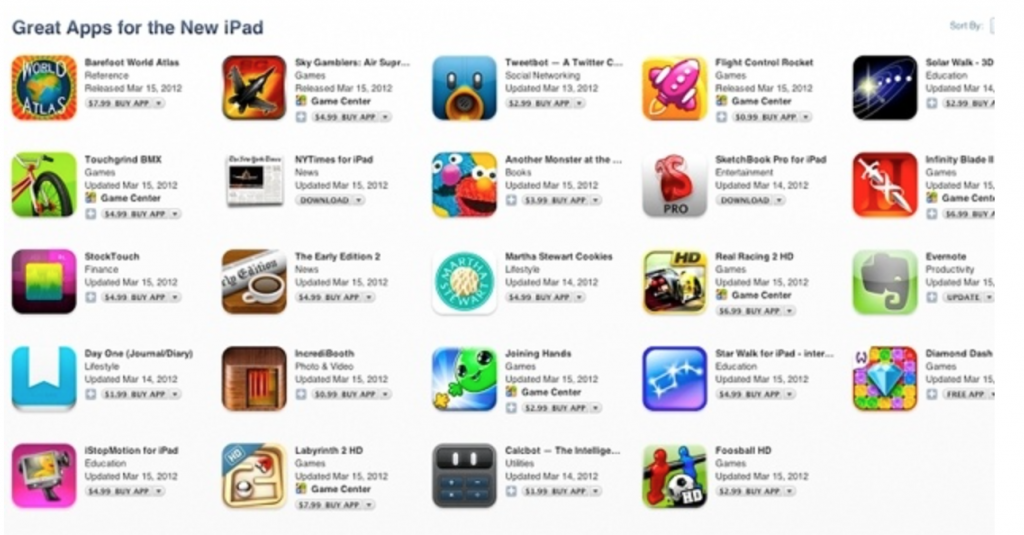
What can we expect?
If mobile commerce continues to dramatically rise in popularity and be widely used around the world. We could see the downfall of store retailers such as Argos and other big department stores. As we have already seen, shops such as blockbuster and GAME have tremendously struggled to compete with the online store of the XBOX and Playstation as game were available online. A survey from Tribute Media (2014) stated that “51% of shoppers research online and visit the store to purchase while 44% research online and purchase online too”. With growing technologies on the mobile, we can expect to see an increase in shopper researching products online and purchasing online too.
According to Google (2014), 41% mobile users have turned to a competitor’s site after a bad mobile experience. This could cause all business with a poor online website and usability site could see falls in profits as more consumers turn to other competitors.
Summary
In my personal opinion, smaller businesses need to embrace this idea, as it will eventually become widely available for all firms and they can be at risk of being left behind by their competitors.
Barnes, S. J., 2002. The mobile commerce value chain: analysis and future developments. International Journal of Information Management, 22(2), 91-108.
Culnan, M. J., & Armstrong, P. K. (1999). Information privacy concerns, procedural fairness, and impersonal trust: An empirical investigation. Organization Science, 10(1), 104–115.
Hoffman, D. L., Novak, T. P., & Peralta, M. (1999). Building consumer trust online. Communications of the ACM, 42(4), 80–85.
Jarvenpaa, S. L., & Tractinsky, N. (1999). Consumer trust in an Internet store: A cross-cultural validation. Journal of Computer Mediated Communication, 5(2), 1–36.
Google Survery. 2014. http://googlemobileads.blogspot.ie/2012/09/mobile-friendly-sites-turn-visitors.html
Rackspace Survery http://www.rackspace.com/knowledge_center/whitepaper/the-ecommerce-customer-experience-0
Reed, D., & Thomas, P. J. (1998). Cascading Style Sheets. In Essential HTML fast (pp. 111-121). Springer London.
Sheehan, K. B., & Hoy, M. G. (1999). Flaming, complaining, abstaining: How online users respond to privacy concerns. Journal of Advertising, 28(3), 37–51.
Smith, A. 2006. Exploring m-commerce in terms of viability growth and challenges. International Journal of Mobile Communication, 4(6) pp.682-703.
Swaminathan, V., Lepkowska-White, E., & Rao, B. P. (1999). Browsers or buyers in cyberspace? An investigation of factors influencing electronic exchange. Journal of Computer Mediated Communication, 5(2), 1-23
You, as an internet user, who has surfed the internet, shopped online or even typed a certain word into google, would have interacted with a recommendation system. It’s becoming more and more apparent these days that this is the sort of digital marketing that is paving our online future. As Neal (2006) noted, this method focuses more on what the customer needs and wants rather than what the company wants to sell. This can also be called ‘database marketing’, which is described by Kauffman (1988) as the collection of information about past, current, and potential customers to build a database to improve the marketing effort. The information includes demographic profiles, consumer likes and dislikes, taste, purchase behaviour and lifestyles.
Amazon is probably the most renowned company who uses this tool. They have stated that this form of marketing generates an additional 10% – 30% of revenue. Other companies such as iTunes (Genius Playlist) and Netflix also use this as a marketing channel.
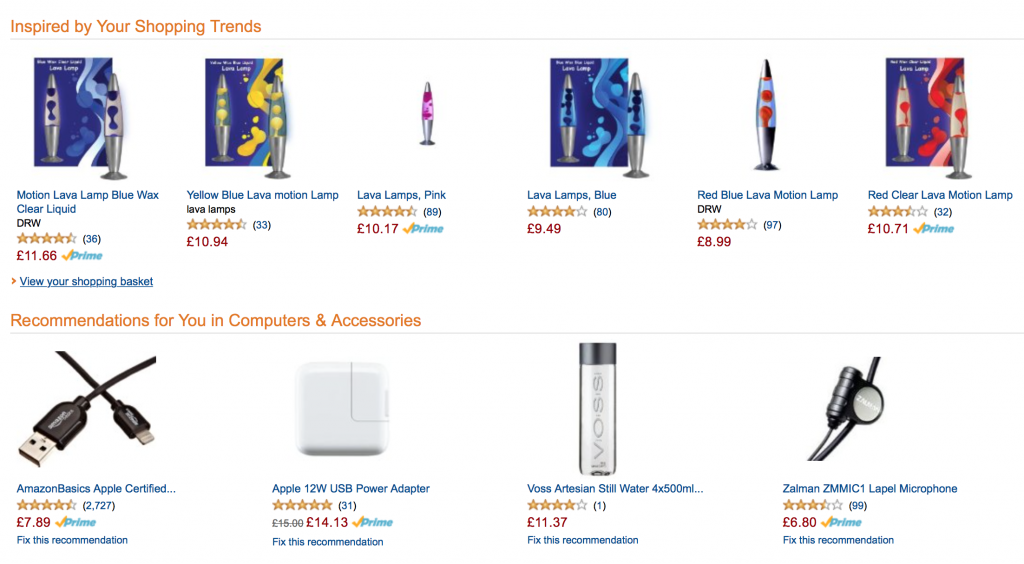
Amazon and other companies are able to monitor how people react to the marketing strategies and campaigns through every click of their mouse. This is vital data for them as they can then ‘group’ people on their similar interests and send over the relevant items. This can be backed up by the marketing theory stated by Kotler (1990), By specialising along market, customer, product, or marketing mix lines, a company can match the unique needs of the customer.
Positives
This allows companies to build a passionate and trustworthy audience. Content personalisation helps build a relationship with the business and consumer as they will feel more valued and respected as a customer.
In regards to Amazon, if there is an easy way for a customer to buy something through the personalisation of the website, they would be more likely to buy it. As seen below, Amazon use a ‘1 click buy’ option which allows an efficient checkout service. Resulting in more purchases from the company.
Visitors who return to a website only to see the same offer over and over are probably not excited. Personalisation through dynamic and different content however, can present something new and relevant to their interests, to visitors each time they arrive on your site.


Negatives
While personalised marketing can reap in benefits for knowing your customer, it does come at a price. Recommendations must be current to be able to maximise engagement to the customer. Especially if these personalisations are through the channel of e-mail. What if the product has become out of stock while the e-mail is being produced to send out? What then?
Also, from an advertiser’s perspective, personalized advertising is typically more expensive than other types of online advertising that is less targeted. The increased costs are generally based on a combination of enhanced benefits of more targeted audiences as well as the need of the ad server to cover the expense of using behavior-monitoring software. As with any advertising alternative, advertisers need to consider the efficiency of paying a certain cost and reaching more or less targeted consumers.
Recommendations
Shani & Cahalasani (1992) suggest an idea that there is a strong resistance from traditional marketers who undertake traditional marketing strategies. However, as a global economy, there is a need for change and the need for people to accept this is important if it is to move on.
There are 3 key areas in which people need to address to perfect the correct personalisation marketing strategy:
- Audience – Knowing your audience is most vital for this marketing strategy to be a success. If you don’t, then you can’t be completely sure in what their favourite interests are.
- Intent – The key to implementing and delivering personalisation is allowing a customer to reveal their intent.
- Relevancy – Show why the message you are presenting is relevant to your customers. This will keep your customer interested in what you are selling and keep purchasing through your website.
References
Neal, B. 2006, Personalized Marketing, Dental Lab Products, vol. 31, no. 2, pp. 52-52,6.
Kauffman, G. (1988), “Direct Marketers Face Some New Realities”, National Underwriter, pp. 21-2.
Kotler,P.(1990), MarketingManagement- Analysis, Planning, Implementation and Control, 7th ed., Prentice-Hall, Englewood Cliffs, NJ.
Shani, D., & Chalasani, S. (1992). Exploiting niches using relationship marketing. The Journal of Consumer Marketing, 9(3), 33.
As Instagram surpasses Twitter for monthly active users, We can explore how brands should/could use the platform to tell their story visually in 2015.
Instagram has attracted a huge global audience, with the number of ‘selfies’ and photos being taken, there are now 300m users documenting their lives, one photo at a time.
1. No matter what your product is, Instagram can make it look like the best product ever.
Because Instagram is a picture upload site, theres no need to describe the product, just pictures relating to it. As long as whatever your posting on Instagram is entertaining, valuable to the customer and relevant, then you’ve got a successful marketing strategy. For example, Sharpie, a permanent market company currently have 110 THOUSAND followers on the site, yet they sell pens? This picture is the reason why….
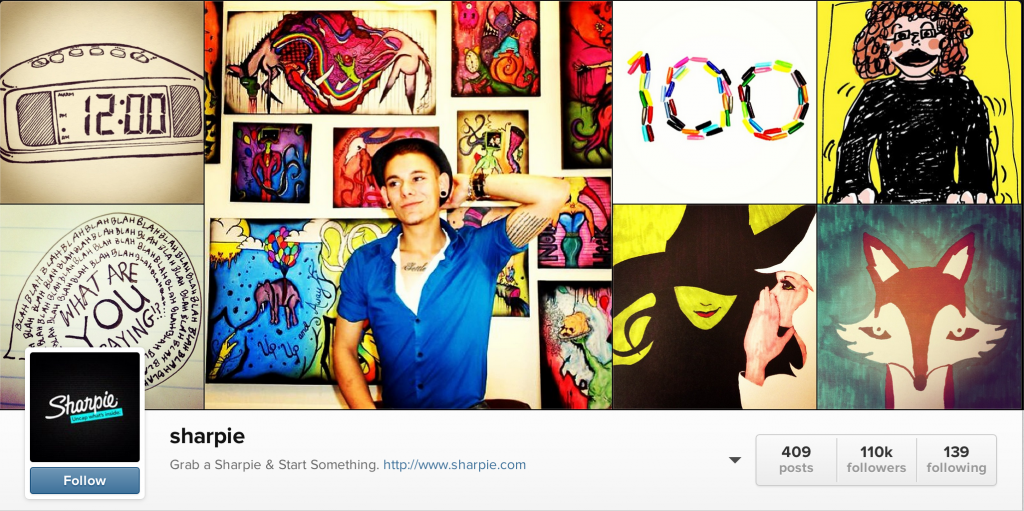
Hand drawn pictures from sharpie users are on display to make a vibrant and capturing page.
2. Trying to reach a larger Audience? Is over 300 Million enough?
With over 300 million people using Instagram on a daily basis it would be criminal to not be using this platform as a digital marketing scheme. Companies such as fashion giants ASOS and Burberry are both racking up a whopping 2.6 million followers. While these are well known companies and already asserted their authority in the fashion industry, they can still use Instagram as a way of showing their new fashion line or their new campaigns that they are so well known for. Burberry also use Instagram in a more personal way mixes in merchandise pictures, as well as behind-the-scenes pictures from photoshoots and commercial filming.


3. The Customers generally do all the work for you…
Instagram can be the perfect way to use other peoples pictures as your own! As mentioned above, Sharpe have capitalised on this and use their customers drawings to decorate their page and show off how good their products are. Another good company who exploit this is Starbucks. By using the Hashtag ‘Regram’ they are allowing their customers to send in their own pictures to put up on their Instagram, as pictured below…

The Future is bright…. But is the future is Instagram?
Applications on phones are becoming increasingly used and loved, which got me thinking, is there an app in which “EVERYONE” loves? With currently 2.9 million available apps on both the apple store and google store (Statista, 2015), odds would suggest that there would be an app which is ‘perfect’ for everyone and anyone. The more that people use apps, the more feedback companies would receive to further better their apps. While not every app is suitable for everyone, Metcalfe Law (Metcalfe, B 1980) states that the value is proportional to the square of the number of users. Which in app terms suggests that the more people who use the app, the more recognised the app.
While i agree with many of my friends about the enjoyment of apps that they rant and rave about, there will always be an app that will suit them, but not myself. This got me researching what sort of things companies would need to introduce/include into their branding of an app which could possibly suit everyone.
So here are 3 suggestions to all of you who are thinking about making an app:
Do something different: Yes, you’ve probably heard this before, but it is probably the best way in which would entice people to download your app. If they can do something that they’ve never done before on their snazzy new smartphone, they will want to see it. This is representative of apps such as one of the very first apps, Carlsbergs ‘iPint’. The concept was simple. Fill up your viral pint, then drink your virtual pint by tipping the glass towards you. It was fun because no one has seen the iphone do that before. It was a great bit of brand engagement, because the only reason you would download the app was to show off to your mates.

Make it useful: While this might sound simple, it is extremely effective. What people want the most is to use their smartphone as much as possible. Creating an app which can help them in everyday life will let these users live this dream and utilise their smartphones even more. This can be related to the AA app which has been heavily downloaded, it gives all traffic information on the road, fuel prices nearby and parking information. While this is not suited to everyone, this gives a small idea on what a good branded app can be like.
Well Targeted: Finally, developing the perfect branded app means not just meeting the brand and campaign objectives, but also being where your users are, which is not necessarily on an iPhone. One great advantage of mobile is that one can target specific demographics through the mobile handset itself something that could not be done through other digital channels. A typical iPhone user represents one of those groups.
These suggestions wont create the perfect app, but it will make you 1 step closer to creating the app that could be branded to everyones tastes.
References:
Statista. (2013). Statistics and Facts about Apps. Available: http://www.statista.com/topics/1729/app-stores/. Last accessed 9th Feb 2015.
endler, J. Golbeck, J. (2011). Metcalfe’s Law, Web 2.0, and the Semantic Web. Rennselaer Polytechnic Institute. (1), 3.
With 95% of my e-mails i read the title and just send them to the trash. But when it comes to adidas, more specifically adidas trainers, i have a very very soft spot for them. I get the occasional sale e-mail and a newsletter every month from them which i scan over every so often.
I have recently bought two pairs of the same shoe, different colours of course, online. I then received an e-mail from them trying to promote a certain shoe a couple of weeks later, the same exact shoe i had bought in stores a couple of weeks beforehand. Due to me buying these shoes on my online account, Adidas already knew that I had bought two pairs of the same shoe and are still trying to sell me more and more.
The E-mail I received was very brightly colour and very vivid with the imagery (Image underneath). This could be Adidas trying to tempt me into buying another pair of shoes, even though they know I have already bought two of these shoes. With the shoe pictured below, when I click on the link, it doesn’t actually have the colour of that shoe and it does not have ‘infinite possibilities’ for the choice of shoe. There is only about 30-40 different designs which is a bit of a disclaimer.
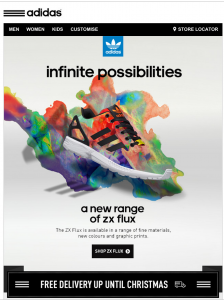
Looking at the picture located above, we can also see they are trying to convince me to spend more on their brand by the ‘Free Delivery’ offer.
Adidas also offer a ‘create your own’ option for this product which is the heaven for all shoe lovers as you can have your favourite colours and styles on your favourite shoe. This is a fantastic marketing tactic for Adidas and i’m sure has plenty of people relishing the thought of creating their own shoe.
Although the email was from a valid Adidas address, it didn’t have a personal hello, or anything specific to me it made it feel as though it was just a standard email with no specific audience which was quite disappointing considering the amount of money I have spent with them.
‘One reason triggered email marketing is so successful is that an automated email system lets you personalise the communication and make it very relevant to the customer.’ (Mohamedi, et al 2013). In regards to this statement, Mohamedi suggest that email marketing is so effective because it lets you personalise the content which is relevant to the customer. While Adidas have included the trainers in which i have bought previously, the no personalisation with my name suggests that Adidas are not completely personal with their audience. This is somewhere where they could potentially improve their service.
References:
Mohammadi, M., Malekian, K., Nosrati, M., & Karimi, R. (2013)
Having read McAfee and Brynjolfsson’s article on Big Data, they suggested that there is a large difference between ‘Big Data’ and ‘Analytics’.
They state that there are 3 major differences which make them totally different.
The first one is the volume of the data. ‘More data crosses the internet every second then the amount of data that was stored 20 years ago.‘ This is a great statistic as it shows how times are changing and how advanced the internet and electronics are evolving. When there is a greater volume amount of data, there is an opportunity to work with more bytes of data in a single data set that isn’t just on the internet.
Second is the Volocity of the data. The speed of the data creation is more important then the volume as it gives a company an advantage over their competitors as it makes them more agile. An example they used was, Andy Pentland from MIT managed to receive data from data locations from smartphones from certain shop car parks which is quick and gave them good market research for future movements.
Final difference is the variety of the data. Different sources of data are becoming increasingly available. This can be through smartphones/Messages/Updates/Images. This means that there are cheaper options available for storage to be able to store the big data.
These 3 key differences suggest that the Big Data is becoming much more managable within a company and how much more effecient it is becoming. This could mean potential advantages over their competitors to have quicker reaction times to market changes therefore a better reputation with their customers. These differences can also help with market research for their customer base as they will have a much larger database for their customers and potential customers.
To be continued…
Reference:
McAfee, A., & Brynjolfsson, E. (2012). Big data: the management revolution. Harvard business review, 90(10), 60-66.
Hello world






























